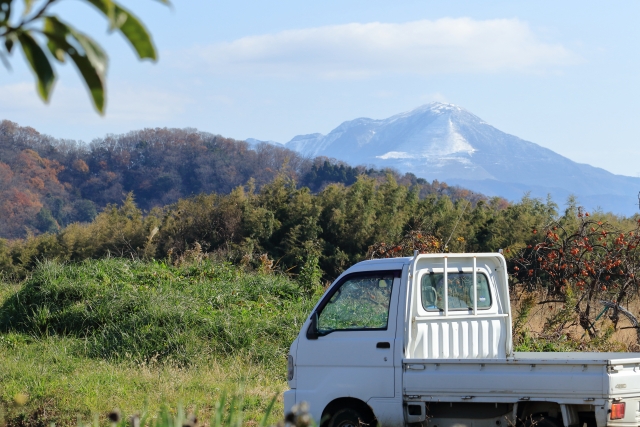The Suzuki Carry is an iconic mini truck (kei truck).
When people think of mini trucks, many immediately answer “Suzuki Carry.” This vehicle is extremely popular as a work vehicle that can navigate rough roads and carry large loads, particularly in the agricultural, forestry, and civil engineering industries.
The first Suzuki Carry was released in 1961, 59 years ago, under the name “Suzu Light Carry” instead of “Suzuki Carry.” The first-generation Suzulight Carry featured a 2-cycle engine with a 360cc displacement, the largest of any mini car at that time. With its simple yet reliable construction and an affordable price point of around 300,000 yen, it quickly gained popularity and secured Suzuki’s position in the commercial minicar market.
In fact, the Suzuki Carry boasts a long record of being the top-selling vehicle in the domestic truck division from 1971 to 2009. As of January 2010, cumulative sales have surpassed 4 million units, making it one of Suzuki’s biggest hits.
Even today, 58 years after its launch, the Suzuki Carry remains a popular vehicle, with the current model being in its 12th generation.
Need a turbo?
Currently, there are turbo models available for various types of vehicles, including regular passenger cars and minicars. Many people also associate turbo cars with speed, even if they don’t know the specifics of how turbos work.
The idea that a “turbo car equals a fast car” isn’t entirely incorrect, but technically speaking, a “powerful car” is a more accurate description.
In order to generate energy, an engine must burn fuel inside it and air is needed to do this. By taking in more air, an engine can generate more power. Turbos use the energy from exhaust gases to rotate a turbine, which compresses air with a compressor and sends it into the engine.
In other words, a turbo engine sends a larger amount of air into the engine than a non-turbo (naturally aspirated) engine, allowing for more power to be extracted from the same displacement.
Advantages of a Turbocharged Car
The most significant advantage of a turbocharged car is that it can produce much more power than a naturally aspirated (NA) engine. Even if the engine has the same displacement as an NA engine, a turbocharged car can deliver the same amount of power as an engine one level up, making it particularly advantageous for cars with lower power output, such as kei cars.
Furthermore, by adding a turbo, it is possible to reduce the engine displacement while maintaining the same power output. As a result, there is an advantage in terms of taxes and other fees, as the vehicle falls into a lower tax bracket.
Disadvantages of a Turbocharged Car
On the other hand, the fuel efficiency of a turbocharged car is usually inferior to that of an NA engine. As previously mentioned, turbochargers use turbines to deliver more air and fuel to the engine, which typically results in slightly lower fuel efficiency. However, advances in technology have improved fuel efficiency in recent years, and the difference between NA and turbocharged engines has become less pronounced.
Secondly, turbocharged engines tend to be more susceptible to breakdowns than NA engines. This is because turbo engines use more parts than NA engines, which increases the risk of component failure.
However, the risk of component failure can be significantly reduced through regular maintenance, such as oil changes and oil filter replacements.
Why the Turbo was Removed from the Carry
As mentioned earlier, the Suzuki Carry mini truck had turbo models available starting from around 1999. However, these turbo models have been discontinued and it is currently not possible to purchase a new Suzuki Carry with a turbo.
So, what led to the disappearance of the turbo model from the Suzuki Carry? There are three main reasons.
Utility as a mini truck
Mini trucks, especially those used in agriculture and forestry, often run on narrow and rough roads. Since the turbo provides extra power, it can cause unexpected accidents by making it difficult to control the vehicle on uneven terrain. Additionally, with too much power, the cargo can collapse or slip. As mini trucks are primarily used for hauling and running well on narrow and uneven roads, the turbo is not necessary.
High Vehicle Price and Maintenance
Turbo engines are generally more expensive than non-turbo engines, costing around 100,000 yen more. They also require more maintenance, such as frequent oil and oil filter changes, checking the amount of cooling water for the engine, and overhauling the turbine. Because many mini trucks are used by the elderly, who may not want to deal with such high levels of maintenance, turbo cars are not selected.
In conclusion, while turbo models were available for the Suzuki Carry mini truck in the past, they were ultimately removed due to concerns over safety and maintenance costs, as well as a lack of need for extra power in the utility-focused mini truck market.
Evolution of NA Engines
In the past, light cars and mini trucks were known for feeling underpowered, but as technology has advanced, the feeling of power shortage in NA engines has greatly reduced. In particular, mini trucks have a light body, and the acceleration is not so bad as to require a turbo. Additionally, NA engines are superior in ease of use, including fuel economy and durability.
Conclusion
In this article, we have focused on turbo cars and explained why the turbo model has been discontinued in the Suzuki Carry. Although the Carry was the only turbo model in the mini truck category, it is no longer available. This is because mini trucks are most commonly used in industries such as agriculture and forestry, and such applications do not require the acceleration provided by turbo engines, and thus are considered unsuitable. Nevertheless, even after the turbo model has been discontinued, the reliability and popularity of the Suzuki Carry remain unchanged, making it a valuable business partner for many years to come.



